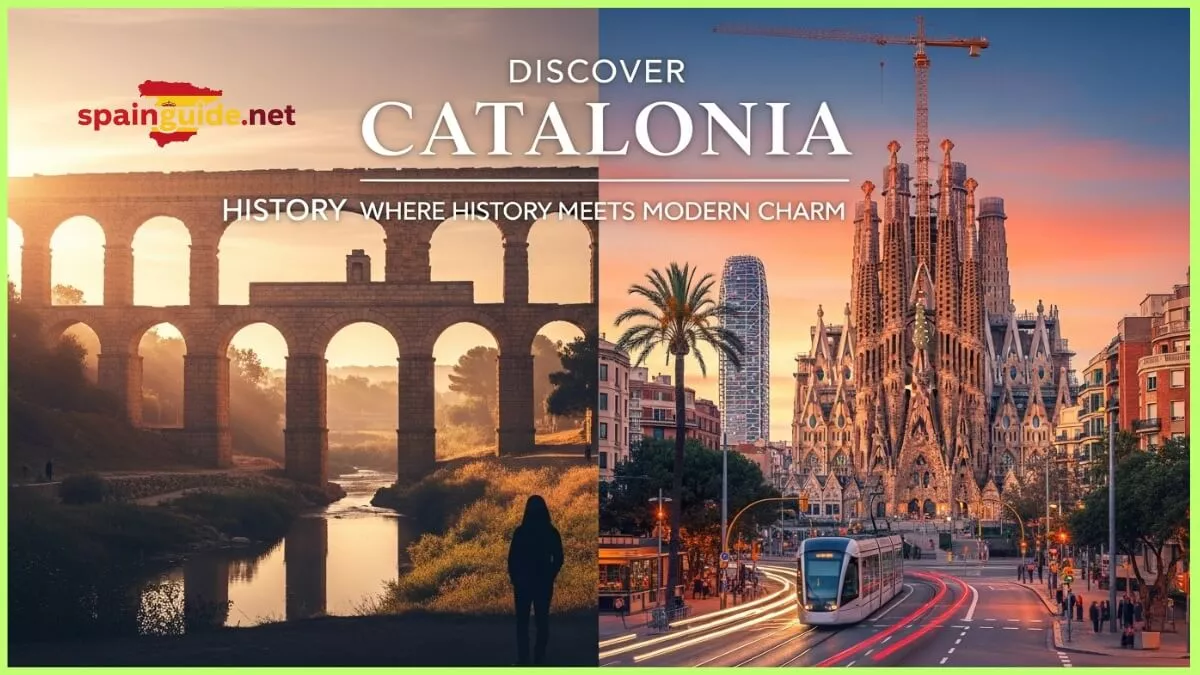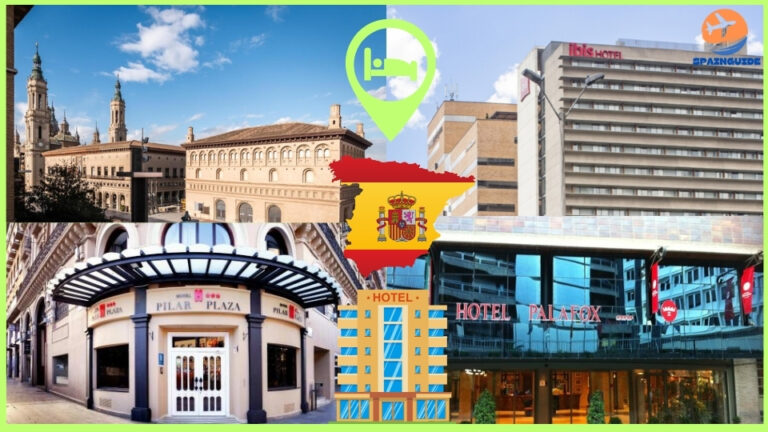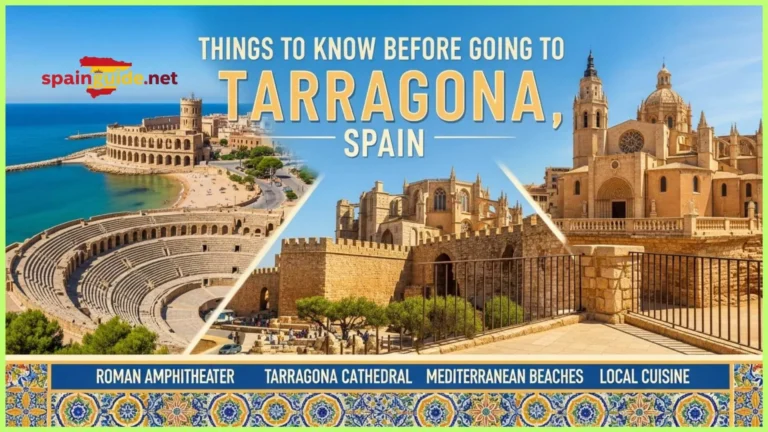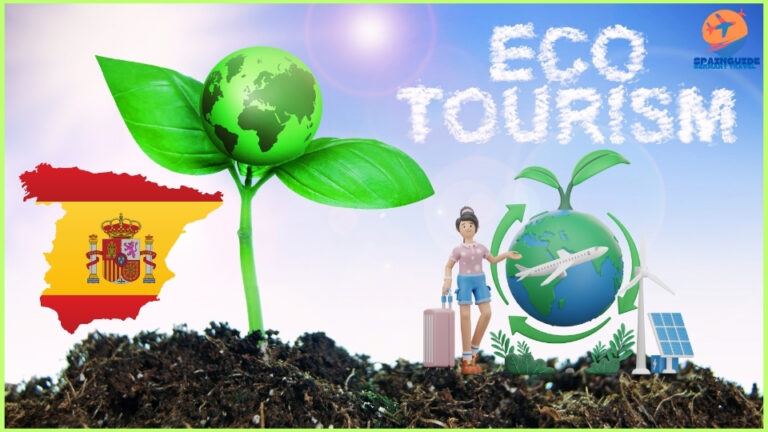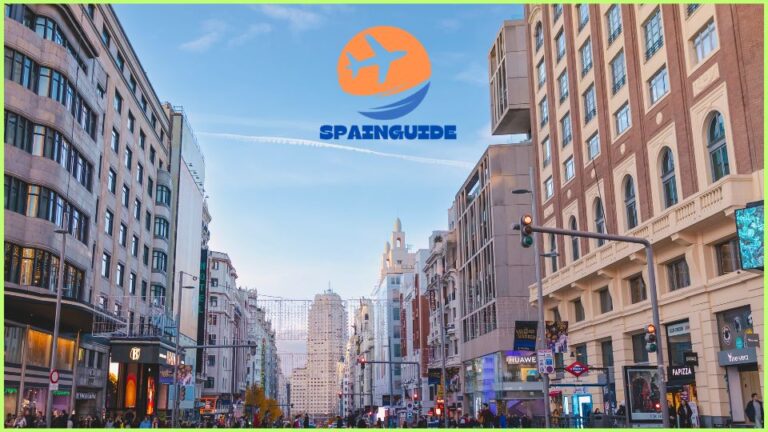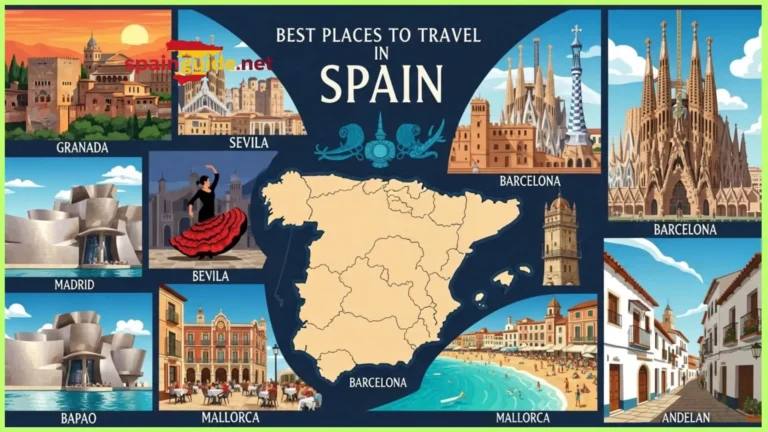So you’re curious about Catalonia? Smart move. This corner of northeastern Spain isn’t just Barcelona (though we’ll get to that beauty). We’re talking Roman ruins where you can practically hear gladiators, medieval towns straight out of a fantasy novel, beaches that’ll make you question ever going back to work, and mountains that beg for hiking boots. Oh, and the food? Let’s just say your taste buds are in for a wild ride.
Here’s the thing: Catalonia does the whole “something for everyone” vibe without feeling like a tourist trap theme park. You can tour Gaudí’s mind-bending architecture in the morning, hit a secret cove by lunch, sip cava in a vineyard by sunset, and catch a human tower competition (yeah, that’s a thing) on Sunday. Ready to plan the perfect trip? Let’s break it down.
Top 5 Must-Dos in Catalonia
- Wander Gaudí’s Barcelona, especially Sagrada Família at sunrise
- Get lost in Girona’s medieval maze and walk the old city walls
- Find your secret beach along Costa Brava’s coastal paths
- Time-travel through Tarragona’s Roman amphitheater
- Hike Aigüestortes National Park in the Pyrenees
Why Catalonia? The Blend That Works
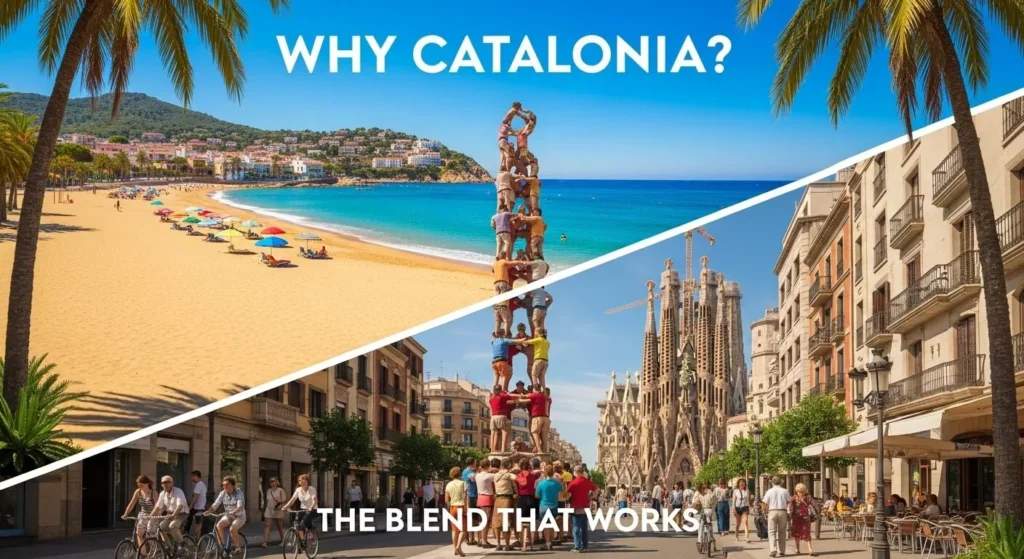
Catalonia isn’t just another Spanish region—it’s got its own language (català), fierce pride, and a design-first mindset that shows up everywhere from street lamps to restaurant menus. The layout’s pretty perfect too: Mediterranean beaches hug one side, Barcelona anchors the middle, and the Pyrenees mountains create this dramatic northern backdrop.
Geography-wise, you’ve got three zones working together: the coast (beaches and port cities), the interior (Barcelona, vineyards, medieval towns), and the mountains (Romanesque churches, hiking trails, ski resorts). It’s like someone designed a region specifically for variety.
When to visit? Spring (April-May) and fall (September-October) are your sweet spots. Mild temps, fewer crowds, and you’ll catch festivals like flower festivals in Girona or grape harvest celebrations. Summer’s gorgeous but packed—especially August when half of Europe camps out on Costa Brava. Winter? Great for skiing up north and having Barcelona almost to yourself.
Barcelona — Capital of Modernisme
Let’s talk about the elephant—or should I say dragon?—in the room. Barcelona isn’t just Catalonia’s capital; it’s an open-air museum of wild architectural experiments that somehow all work together.
The Gaudí hits: Start with Sagrada Família because… I mean, come on. Book your ticket weeks ahead for early morning—trust me, the light’s magical and you’ll dodge half the selfie sticks. Park Güell’s mosaic lizard is Instagram gold (get there right when it opens). ¿Casa Batlló y La Pedrera? Both trippy, both worth it. Pick one if you’re on a budget; do both if you’re an architecture nerd.
Old-town magic: The Gothic Quarter is moody and maze-like in the best way. Get deliberately lost, pop into tiny squares, find hole-in-the-wall bars. El Born’s hipper—vintage shops, the Picasso Museum, and Santa Maria del Mar church (free, stunning, zero crowds). La Barceloneta’s your beach fix with a side of paella and people-watching.
Food scene: Hit La Boqueria market for breakfast (pa amb tomàquet toast and fresh juice), but go early before tour groups invade. For tapas, skip Las Ramblas and head to Gràcia or Poble Sec neighborhoods. Vermouth culture’s huge here—grab a glass of sweet vermouth before lunch like locals do.
Pro moves: Buy a T-10 transit card (works on metro and buses). Book major site tickets online. Casa Batlló at night? Different experience, fewer people. Sundays mean free museum afternoons but also siesta closures—plan accordingly.
Girona & the Costa Brava — Medieval Walls to Secret Coves
If Barcelona’s the flashy friend, Girona’s the cool, mysterious one. This medieval gem sits about an hour north and punches way above its size.
Girona highlights: Walk the ancient city walls for panoramic views (and Game of Thrones bragging rights). The colorful houses along the Onyar River are postcard perfect. The Jewish Quarter (El Call) is one of Europe’s best-preserved—narrow, atmospheric, humbling. Arab Baths are actually Romanesque but still beautiful. Don’t skip the cathedral steps—yes, those steps from the show.
Dalí triangle: The artist’s theatrical museum in Figueres is bonkers in the best way—melting clocks, a car that “rains” inside, and his actual tomb. His house in Portlligat (near Cadaqués) shows where the madness was born. Book ahead for both. Cadaqués itself is this whitewashed fishing village that feels untouched by time.
Costa Brava magic: The “Wild Coast” lives up to its name. Tossa de Mar has a fortified old town right on the beach. Calella de Palafrugell is postcard Spain—tiny coves, fishing boats, seafood restaurants with tables in the sand. The coastal path (the camins de ronda) connects beaches and is absolutely stunning. Rent a kayak, bring snorkeling gear, or just claim a cove and pretend you live there.
Tarragona & the Costa Daurada — Roman Legacy by the Sea
Tarragona doesn’t get the hype it deserves. It’s got UNESCO Roman ruins, Mediterranean beaches, and way fewer tourists than Barcelona. Win-win-win.
Roman glory: The amphitheater sits right by the sea—imagine watching gladiator fights with that view. The forum, circus, and ancient walls are scattered through town (get the combined ticket). The aqueduct (Les Ferreres) sits outside the city, and you can walk on top of it. History nerds, this is your jam.
Golden Coast towns: Sitges is artsy, beachy, and has killer Carnival celebrations. Salou’s family-friendly with theme parks nearby. Cambrils is the seafood capital—seriously, the fish here is unreal. All three have golden sand beaches (hence “Costa Daurada”) and laid-back vibes.
Wine and monks: The Cistercian Route connects three medieval monasteries—Poblet’s the star with jaw-dropping cloisters. DO Tarragona wines are underrated; lots of small wineries do tastings without the Penedès crowds.
Lleida & the Pyrenees — Nature, Romanesque, Adventure
The mountains are Catalonia’s secret weapon. Less touristy, more dramatic, perfect for when you need a city break.
Vall de Boí churches: Tiny Romanesque gems scattered through valleys—UNESCO-listed and painted with medieval frescoes. The architecture is simple and powerful. It’s remote, but that’s the point.
Aigüestortes National Park: Glacial lakes, pine forests, peaks that’ll make your phone run out of storage. Summer hiking’s spectacular. Pack layers—weather changes fast up here.
Adventure central: Via ferrata routes for adrenaline junkies. Rock climbing spots. In winter, Baqueira-Beret is Spain’s best ski resort (also the most expensive, but worth it). Spring means wildflowers and waterfalls; fall brings insane foliage colors.
Penedès, Priorat & Empordà — Wine and Cava Country
Catalonia doesn’t mess around with wine. Three regions, three totally different vibes.
Penedès cava: This is where Spain’s sparkling wine comes from. The big names (Freixenet, Codorníu) have impressive tours, but smaller family wineries are more intimate and often cheaper. Book tastings ahead—show up with a designated driver or use their shuttle services.
Priorat’s bold reds: Steep slate hills, intense wines, tiny production. It’s pricey but legendary. Neighboring Montsant gives you similar vibes for less cash. The scenery alone—terraced vineyards on impossible slopes—is worth the drive.
Empordà near Costa Brava: Wine tourism meets beach vacations. Lighter wines, great rosés, perfect with local seafood. Combine a morning tasting with an afternoon beach session.
Culture & Traditions — Living Heritage
Catalonia’s cultural identity runs deep, and you’ll feel it everywhere.
Castells (human towers): Teams build 6-10 story human pyramids, kids scramble to the top, crowds hold their breath. It’s equal parts sport, art, and tradition. Major competitions happen during festivals—La Mercè in Barcelona (late September) is your best bet. Respect the silence when towers are rising; cheer when they succeed.
Festivals: Fire-running (correfoc) with sparklers and dragons? Check. Circle dancing (sardana) in squares? Absolutely. Temps de Flors turns Girona into a flower wonderland every May. Each town has its own festa major—locals dress up, build castells, party for days.
Design legacy: Modernisme isn’t just Gaudí. Check out Domènech i Montaner’s Hospital de Sant Pau and Palau de la Música. Puig i Cadafalch’s Casa Amatller. The style’s everywhere—streetlights, benches, balconies. Once you notice it, you can’t stop.
Catalan Cuisine — From Market to Michelin
The food here deserves its own passport stamp.
Essentials to try:
- Pa amb tomàquet: tomato-rubbed bread with olive oil—sounds basic, tastes like heaven
- Calçots with romesco: grilled spring onions with nutty red pepper sauce (winter/spring specialty)
- Escalivada: roasted peppers and eggplant, simple perfection
- Fideuà: paella’s noodle cousin, often better
- Suquet de peix: fisherman’s stew from coastal towns
- Botifarra: Catalan sausage, grilled or in stews
Seasonal stars: Calçotades are winter/spring festivals centered around those onions—messy, fun, delicious. Summer means seafood everywhere along the coast. Fall brings mushroom mania (bolets) in mountain regions.
Where to eat: Old-school bodegas for traditional vibes and cheap wine. Market bars inside La Boqueria or Santa Caterina for fresh, simple dishes. Contemporary Catalan restaurants blend tradition with modern techniques—Barcelona’s got tons, but smaller cities surprise too. Always ask locals; they’ll steer you right.
3 Sample Itineraries
3 days—Barcelona deep dive:
- Day 1: Sagrada Família morning, Gothic Quarter, sunset at Barceloneta beach
- Day 2: Park Güell early, El Born cafés, Casa Batlló evening, Gràcia tapas
- Day 3: La Pedrera, La Boqueria brunch, Montjuïc castle, and magic fountain show
5 days—City + coast:
- Days 1-2: Barcelona highlights from above
- Day 3: Montserrat day trip (monastery, hiking, choir at 1 pm)
- Day 4: Train to Girona, explorethe old town, sleep there
- Day 5: Costa Brava beach-hopping, back to Barcelona
7 days—Grand tour:
- Days 1-3: Barcelona extended
- Day 4: Tarragona Romans + Sitges beach stop
- Days 5-6: Girona medieval + Costa Brava coves
- Day 7: Penedès cava tour OR Pyrenees nature escape
Practical Tips
Getting around: Barcelona’s metro is easy and cheap. Rodalies trains connect nearby cities. RENFE regional trains reach Girona, Tarragona, Lleida. Buses fill gaps (ALSA is the main company). Rent a car for Costa Brava, hidden beaches, or Pyrenees villages—parking in Barcelona’s a nightmare, skip it there.
Passes and bookings: Buy Barcelona major site tickets online days ahead—they sell out. Some museums offer combined passes. Wineries need reservations. Restaurants in hot spots (Barcelona, Cadaqués) should be booked for dinner. Montserrat choir performs at 1 pm weekdays, noonon Sundays.
Budget reality: Barcelona’s pricey; everywhere else is cheaper. Expect €15-25 for decent restaurant meals outside the city, €25-40 in Barcelona. Museums run €10-15. Wine tastings €15-30. Hotels from €60, hostels to €200+ boutique stays. Sundays and Mondays mean closures—check before planning.
Siesta’s real: Shops close 2-5 pm, especially outside Barcelona. Banks and offices close Saturday afternoons. Plan around it or embrace naptime.
Responsible Travel
Tourism’s strained some spots (looking at you, Park Güell neighborhood). Here’s how not to be that tourist:
Support locals: Eat at family-run restaurants, not chains. Buy from artisans and small producers. Stay in local-owned hotels when possible. Shop at neighborhood markets.
Crowd-smart: Visit big sights early morning or late afternoon. Skip peak summer if you can. Explore lesser-known neighborhoods. Respect residential areas—locals actually live in the Gothic Quarter.
Nature care: Stick to marked trails in parks and coastal paths. Don’t leave trash on beaches. Water’s scarce in summer—conserve it. Some coves are protected; check the rules before visiting.
Catalonia’s one of those places that keeps surprising you. One minute you’re geeking out over a 2,000-year-old aqueduct, the next you’re eating the best seafood of your life with your toes in the sand. It’s manageable in size but packed with variety. Whether you’re here for Gaudí’s wild vision, Roman history, secret beaches, mountain trails, or just really good wine and food (honestly, that’s reason enough), you’re in for something special.
FAQs
Is Catalonia different from Spain culturally?
Yeah, significantly. Catalonia has its own language (català, not a dialect—a separate Romance language), distinct traditions, and a strong regional identity. Most people speak both Catalan and Spanish. Signs are in Catalan; menus usually have both. It’s sensitive territory politically, so just be respectful and aware.
What is Modernisme in Barcelona?
Catalonia’s version of Art Nouveau, roughly 1890-1910. Architects like Gaudí, Domènech i Montaner, and Puig I Cadafalch created wild, organic, detailed buildings inspired by nature, Catalan identity, and pure imagination. It’s why Barcelona looks like no other city on earth.
Best time to visit Costa Brava?
June and September are perfect—warm water, good weather, manageable crowds. July-August is peak chaos (and priciest). May’s lovely but water’s still cool. October is quie,t but some beach restaurants close. Avoid winter unless you’re just exploring towns, not beaches.
How many days are enough for Catalonia?
Minimum 5 days to scratch the surface (Barcelona plus one other area). A week lets you mix city, coast, and countryside comfortably. Two weeks means you can really dig in without rushing. Even 3 days in Barcelona alone works if that’s all you’ve got.
Do you need a car outside Barcelona?
Not strictly necessary—trains and buses connect main spots—but highly recommended for Costa Brava’s hidden beaches, Priorat wineries, Pyrenees villages, and small-town flexibility. Just don’t drive in Barcelona; park outside and train in.
Ready to start planning? Check out our detailed Barcelona Modernisme guide, dig into the Girona and Costa Brava beach guide, explore Tarragona’s Roman route, or browse our Catalan food dictionary to know what to order. Time to book that trip.

